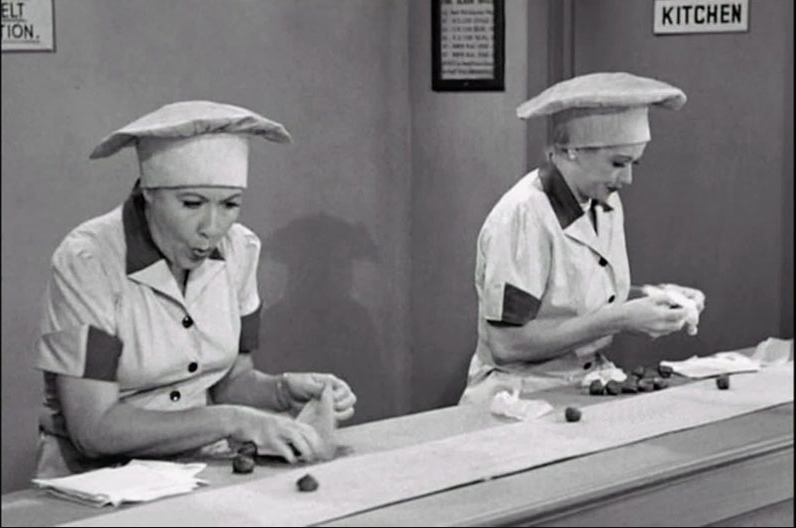Lucy and Ethel at the Chocolate Factory
While humans communicate with words, we don’t understand with words. We understand with images. The use of mental images is so intuitive that we often don’t know we’re doing it, but stop reading for a moment and think of something complex that you understand (an internal combustion engine, the workings of Congress, the proper way to make a souffle, etc.) If you think to yourself, “What’s going on in my mind that allows me to grasp this?” you won’t find words, you’ll find pictures (or mental models, if you prefer the academic term). The level of our competence is tied to the usefulness and accuracy of our mental models.
So, of course, I think about this in terms of writing. I’ve got plenty of writing-related mental models, many too ill-formed or idiosyncratic to be worth sharing. There is one, however, one that I have found especially useful, probably because it’s the simplest – the idea of a novel as a conveyor belt.
The more I understand the process of writing a novel, the more I have learned to visualize books as assembly lines of information. I have an image of all the sentences in a book stretched out in a single line that slowly progresses past the reader’s eyes. Doing some rough math, for a 300-page book, all the words stretched end-to-end would be about 3,000 feet. Over half a mile. That’s a lot of information to be delivered to a single person and, if you’re not careful, the reader can easily be overwhelmed by this conveyor belt of data.
When you think of assembly line workers getting overwhelmed, the classic image that appears is Lucy and Ethel at the chocolate factory. (For younger readers, click here.) By the end, they’re stuffing chocolate in their hats and shirts, unable to keep up with the frenzied pace. How many books have you read that made you feel that way? If you’re a writer, does your writing have that effect on readers?
There are two ways to screw up the conveyor belt. The first is to overwhelm. In an attempt to ratchet up the tension, the writer has five things going on at once. You’ll find this in glossy paperback thrillers that you pick up at the airport. On occasion these will hit it out of the park, the author able to expertly juggle all the hijinks (The Girl with the Dragon Tattoo comes to mind). However, it’s more often my experience that reading these type books leaves me overwhelmed. On page 1 the unshaven anti-hero wakes up to find a Soviet spy in his hotel closet, and promptly breaks the guy’s neck. From there, the pace never lets up. 300 pages later, I’m dazed. There’s too much action and none of it feels earned. Metaphorically speaking, my shirt and hat are stuffed with unwrapped chocolates.
Of course, you can screw up a book in the opposite direction, too. This sin is committed by the more literary set (or should it be “literary”? Why do I feel that word needs quotes?) These are the character-driven books that you plod through because they were short-listed for something or other. At the sentence-level the writing might be top notch, but nothing fucking happens. Lucy and Ethel are waiting for the chocolates, but the conveyor belt trundles by with a lot of nothing on it. Sparkling sentences and mopey characters paralyzed by ennui don’t cut it for the average reader, most of whom aren’t tweed-jacket wearing literature professors. People pick up books because they want to be taken somewhere. The conveyor belt doesn’t have to travel at the speed of a Japanese bullet train, but it needs to move.
As I revise, Lucy and Ethel are who I’m thinking about. If my dreams for this book come true, it will one day be read by complete strangers. These people will have nothing invested in me; they are picking up the book purely with the hope of being entertained. As soon as they hit page 1, the conveyor belt starts. Hopefully, I can calibrate it in a way that satisfies.
